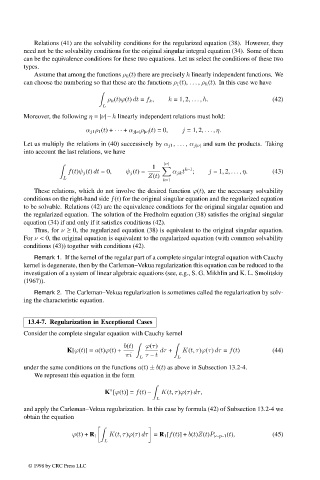Page 672 - Handbook Of Integral Equations
P. 672
Relations (41) are the solvability conditions for the regularized equation (38). However, they
need not be the solvability conditions for the original singular integral equation (34). Some of them
can be the equivalence conditions for these two equations. Let us select the conditions of these two
types.
Assume that among the functions ρ k (t) there are precisely h linearly independent functions. We
can choose the numbering so that these are the functions ρ 1 (t), ... , ρ h (t). In this case we have
ρ k (t)ϕ(t) dt = f k , k =1, 2, ... , h. (42)
L
Moreover, the following η = |ν| – h linearly independent relations must hold:
α j1 ρ 1 (t)+ ··· + α j|ν| ρ |ν| (t)=0, j =1, 2, ... , η.
Let us multiply the relations in (40) successively by α j1 , ... , α j|ν| and sum the products. Taking
into account the last relations, we have
|ν|
1 k–1
f(t)ψ j (t) dt =0, ψ j (t)= α jk t ; j =1, 2, ... , η. (43)
L Z(t)
k=1
These relations, which do not involve the desired function ϕ(t), are the necessary solvability
conditions on the right-hand side f(t) for the original singular equation and the regularized equation
to be solvable. Relations (42) are the equivalence conditions for the original singular equation and
the regularized equation. The solution of the Fredholm equation (38) satisfies the original singular
equation (34) if and only if it satisfies conditions (42).
Thus, for ν ≥ 0, the regularized equation (38) is equivalent to the original singular equation.
For ν < 0, the original equation is equivalent to the regularized equation (with common solvability
conditions (43)) together with conditions (42).
Remark 1. If the kernel of the regular part of a complete singular integral equation with Cauchy
kernel is degenerate, then by the Carleman–Vekua regularization this equation can be reduced to the
investigation of a system of linear algebraic equations (see, e.g., S. G. Mikhlin and K. L. Smolitskiy
(1967)).
Remark 2. The Carleman–Vekua regularization is sometimes called the regularization by solv-
ing the characteristic equation.
13.4-7. Regularization in Exceptional Cases
Consider the complete singular equation with Cauchy kernel
b(t) ϕ(τ)
K[ϕ(t)] ≡ a(t)ϕ(t)+ dτ + K(t, τ)ϕ(τ) dτ = f(t) (44)
πi τ – t
L L
under the same conditions on the functions a(t) ± b(t) as above in Subsection 13.2-4.
We represent this equation in the form
◦
K [ϕ(t)] = f(t) – K(t, τ)ϕ(τ) dτ,
L
and apply the Carleman–Vekua regularization. In this case by formula (42) of Subsection 13.2-4 we
obtain the equation
K(t, τ)ϕ(τ) dτ = R 1 [f(t)] + b(t)Z(t)P ν–p–1 (t), (45)
ϕ(t)+ R 1
L
© 1998 by CRC Press LLC
© 1998 by CRC Press LLC
Page 655

